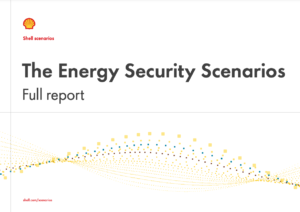Full Title: The Energy Security Scenarios: Full Report
Author(s): Shell scenarios
Publisher(s): Shell
Publication Date: April 15, 2023
Full Text: Download Resource
Description (excerpt):
What we present here are scenarios. To get the most from them, it is important to know what these are and what they
are not. They are an exploration of how the world could possibly evolve under different sets of assumptions. They are informed by data, constructed using models and contain insights from leading experts in the relevant fields.
As recently as 2021, at COP26 in Glasgow, world leaders gathered and collectively promised to deliver on the stretch goal of the Paris Agreement and limit global warming to 1.5 degrees Celsius (1.5°C). Yet, within months, the Russian invasion of Ukraine had caused political upheaval and pointed society in a different direction. In the wake of COP27 in Sharm el-Sheikh, this publication seeks to explore the landscape global society now inhabits and what the trends visible in 2022 could mean for the future. There is a particular focus on the potential climate outcomes for the planet. In one scenario, we look at how things could evolve if current trends continue and, in another, we look at a possible optimistic future. Finally, we discuss how the world could switch from where it appears to be headed, towards a lower-carbon future.
In Archipelagos, the security mindset emerging in 2022 takes hold worldwide. Global sentiment shifts away from managing emissions towards energy security. Despite this, the drive for energy security still involves significant use of low-carbon technologies. These dynamics translate into global emissions stabilizing in the 2020s, and falling from the mid-2030s. This makes for a faster energy transition compared to the 2021 Islands scenario.
In Sky 2050, the war in Ukraine translates into an uneven start as short-term energy security concerns dominate. Over time, however, a longer-term perspective on security emerges which includes the need to meet the threat of climate change. Momentum towards emissions reductions then gathers pace as the need to deliver low-carbon energy infrastructure grows, driven largely by concerns over security and price. While progress does not meet the most optimistic expectations, emissions start to fall from 2025. By 2040, the goal of net-zero emissions is clearly in sight.
